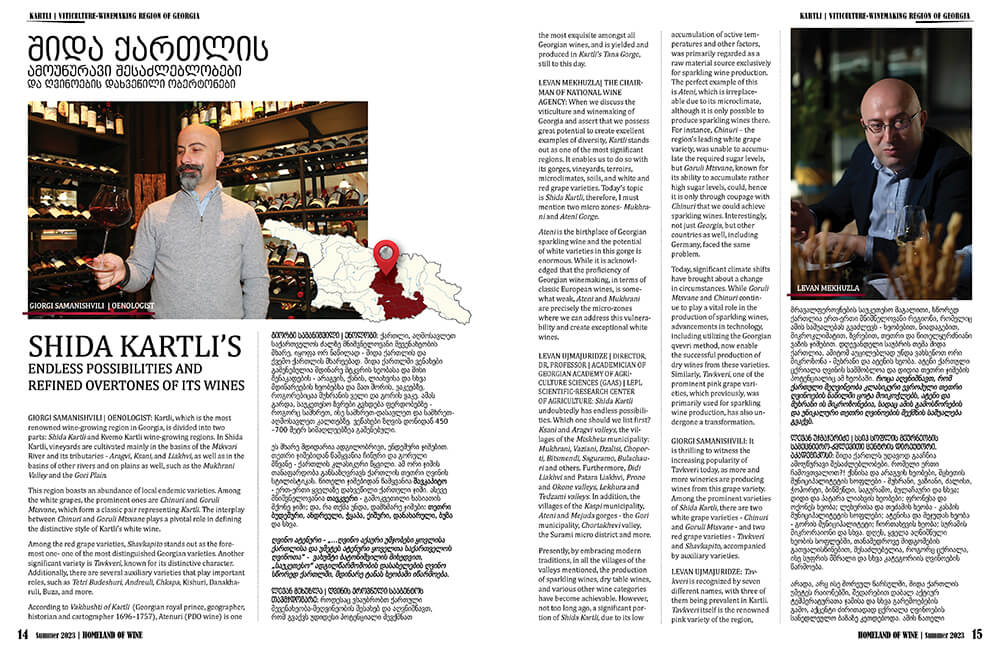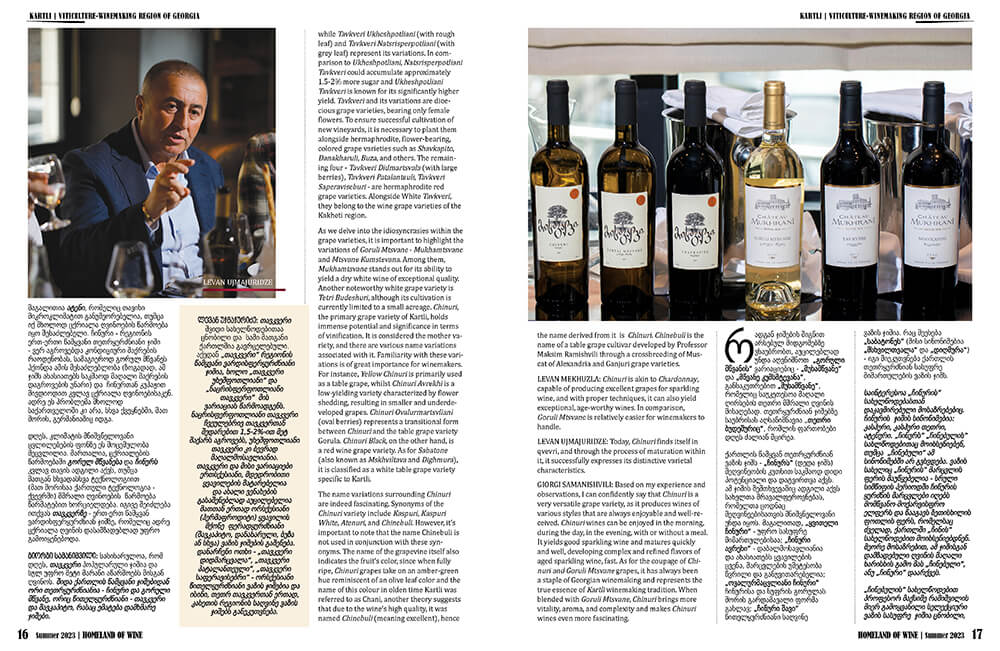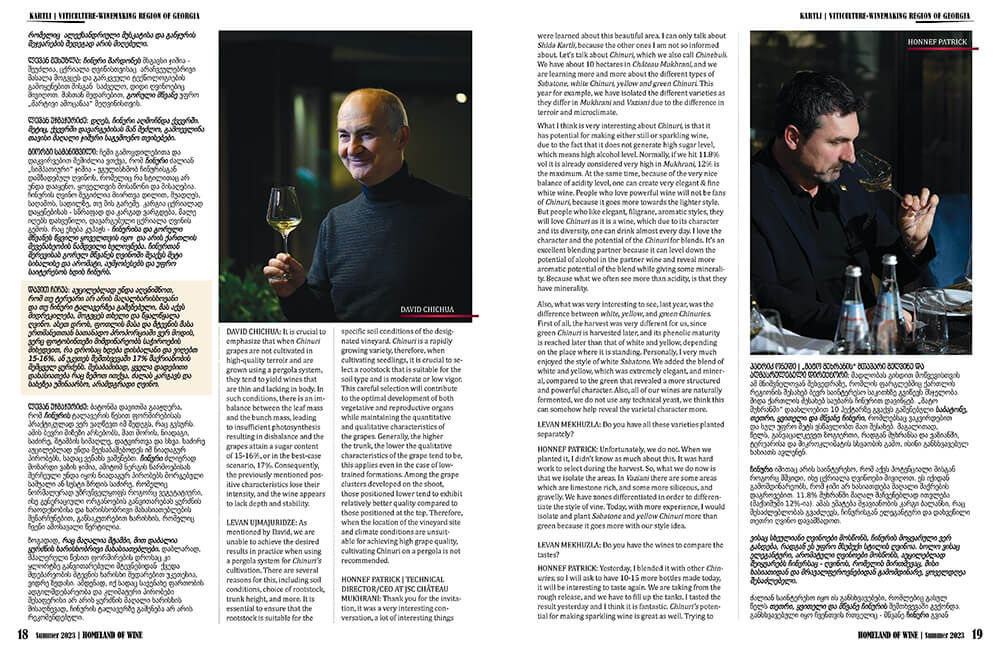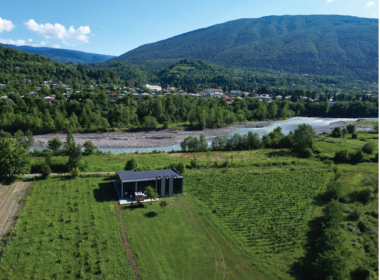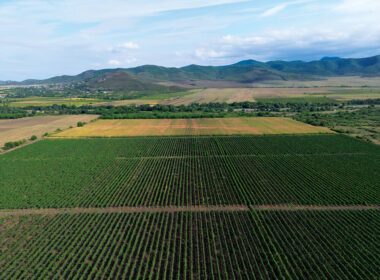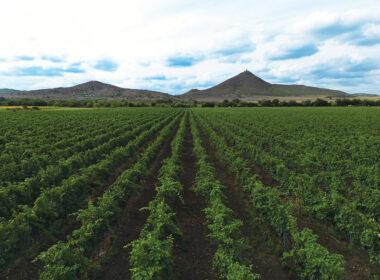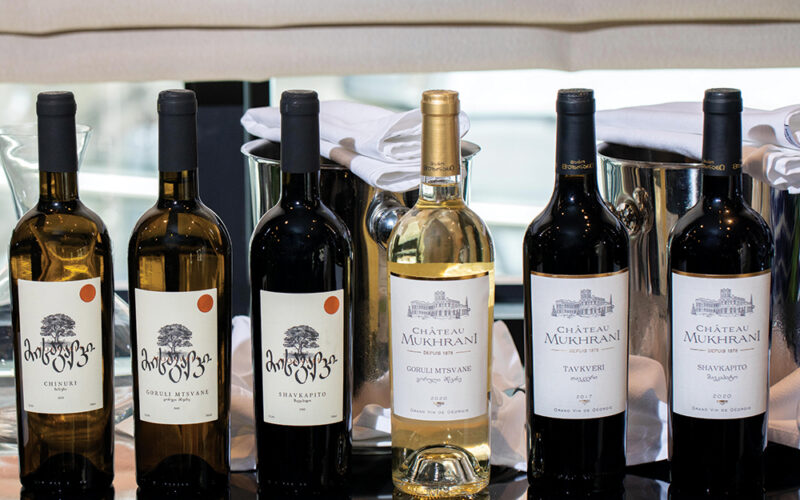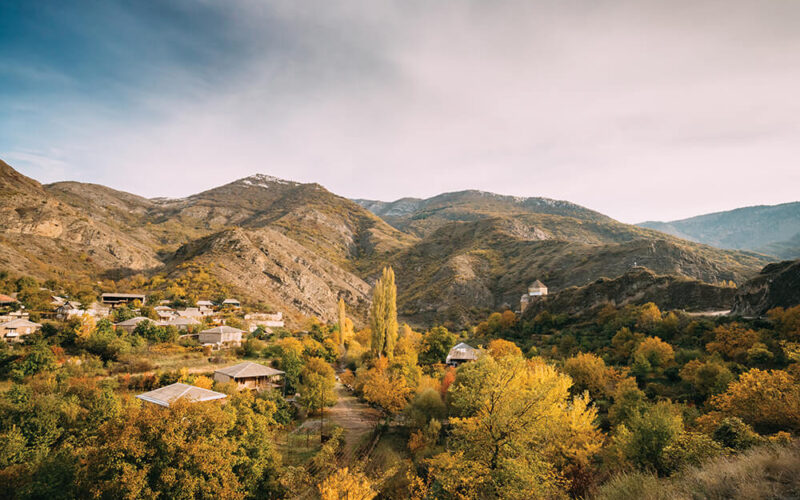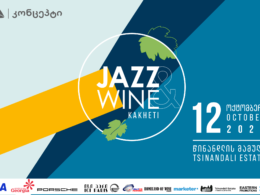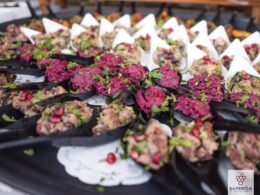| Part I |
Giorgi Samanishvili | Oenologist: Kartli, which is the most renowned wine-growing region in Georgia, is divided into two parts: Shida Kartli and Kvemo Kartli wine-growing regions. In Shida Kartli, vineyards are cultivated mainly in the basins of the Mtkvari River and its tributaries – Aragvi, Ksani, and Liakhvi, as well as in the basins of other rivers and on plains as well, such as the Mukhrani Valley and the Gori Plain.
This region boasts an abundance of local endemic varieties. Among the white grapes, the prominent ones are Chinuri and Goruli Mtsvane, which form a classic pair representing Kartli. The interplay between Chinuri and Goruli Mtsvane plays a pivotal role in defining the distinctive style of Kartli’s white wine.
Among the red grape varieties, Shavkapito stands out as the foremost one- one of the most distinguished Georgian varieties. Another significant variety is Tavkveri, known for its distinctive character. Additionally, there are several auxiliary varieties that play important roles, such as Tetri Budeshuri, Andreuli, Chkapa, Kishuri, Danakharuli, Buza, and more.
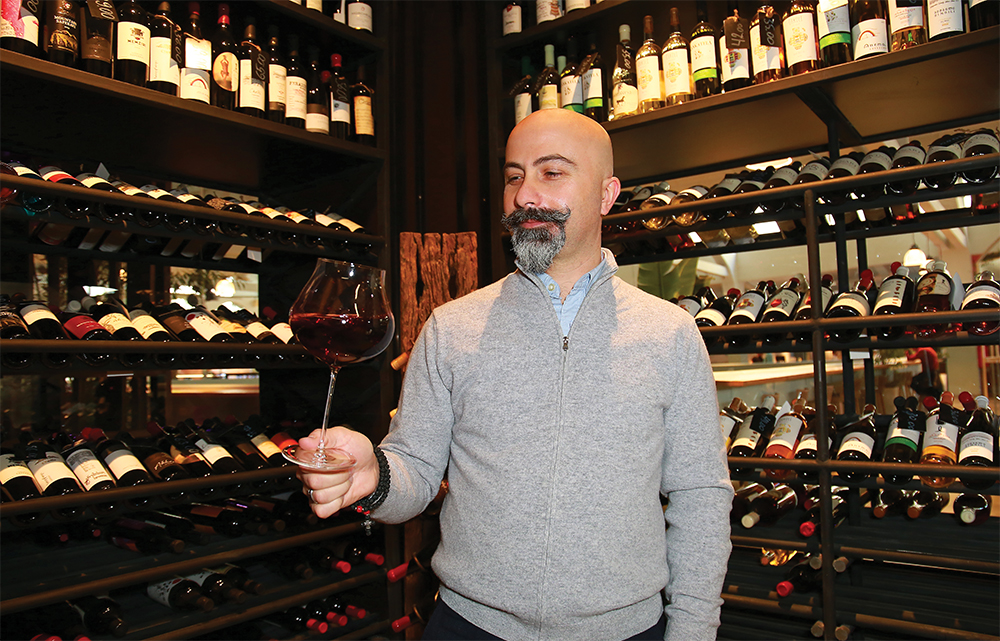
According to Vakhushti of Kartli (Georgian royal prince, geographer, historian and cartographer 1696–1757), Atenuri (PDO wine) is one the most exquisite amongst all Georgian wines, and is yielded and produced in Kartli’s Tana Gorge, still to this day.
Levan Mekhuzla| The Chairman of National Wine Agency: When we discuss the viticulture and winemaking of Georgia and assert that we possess great potential to create excellent examples of diversity, Kartli stands out as one of the most significant regions. It enables us to do so with its gorges, vineyards, terroirs, microclimates, soils, and white and red grape varieties. Today’s topic is Shida Kartli, therefore, I must mention two micro zones- Mukhrani and Ateni Gorge.

Ateni is the birthplace of Georgian sparkling wine and the potential of white varieties in this gorge is enormous. While it is acknowledged that the proficiency of Georgian winemaking, in terms of classic European wines, is somewhat weak, Ateni and Mukhrani are precisely the micro-zones where we can address this vulnerability and create exceptional white wines.
Levan Ujmajuridze | Director, Dr, Professor | Academician of Georgian Academy of Agriculture Sciences (GAAS) | LEPL SCIENTIFIC-RESEARCH CENTER OF AGRICULTURE: Shida Kartli undoubtedly has endless possibilities. Which one should we list first? Ksani and Aragvi valleys, the villages of the Mtskheta municipality: Mukhrani, Vaziani, Dzalisi, Choporti, Bitsmendi, Saguramo, Bulachauri and others. Furthermore, Didi Liakhvi and Patara Liakhvi, Prone and Okone valleys, Lekhura and Tedzami valleys. In addition, the villages of the Kaspi municipality, Ateni and Mejuda gorges – the Gori municipality, Chortakhevi valley, the Surami micro district and more.
Presently, by embracing modern traditions, in all the villages of the valleys mentioned, the production of sparkling wines, dry table wines, and various other wine categories have become achievable. However, not too long ago, a significant portion of Shida Kartli, due to its low accumulation of active temperatures and other factors, was primarily regarded as a raw material source exclusively for sparkling wine production. The perfect example of this is Ateni, which is irreplaceable due to its microclimate, although it is only possible to produce sparkling wines there. For instance, Chinuri – the region’s leading white grape variety, was unable to accumulate the required sugar levels, but Goruli Mtsvane, known for its ability to accumulate rather high sugar levels, could, hence it is only through coupage with Chinuri that we could achieve sparkling wines. Interestingly, not just Georgia, but other countries as well, including Germany, faced the same problem.

Today, significant climate shifts have brought about a change in circumstances. While Goruli Mtsvane and Chinuri continue to play a vital role in the production of sparkling wines, advancements in technology, including utilizing the Georgian qvevri method, now enable the successful production of dry wines from these varieties. Similarly, Tavkveri, one of the prominent pink grape varieties, which previously, was primarily used for sparkling wine production, has also undergone a transformation.
Giorgi Samanishvili: It is thrilling to witness the increasing popularity of Tavkveri today, as more and more wineries are producing wines from this grape variety. Among the prominent varieties of Shida Kartli, there are two white grape varieties – Chinuri and Goruli Mtsvane – and two red grape varieties – Tavkveri and Shavkapito, accompanied by auxiliary varieties.
Levan Ujmajuridze: Tavkveri is recognized by seven different names, with three of them being prevalent in Kartli. Tavkveri itself is the renowned pink variety of the region, while Tavkveri Ukheshpotliani (with rough leaf) and Tavkveri Natsrisperpotliani (with grey leaf) represent its variations. In comparison to Ukheshpotliani, Natsrisperpotliani Tavkveri could accumulate approximately 1.5-2% more sugar and Ukheshpotliani Tavkveri is known for its significantly higher yield. Tavkveri and its variations are dioecious grape varieties, bearing only female flowers. To ensure successful cultivation of new vineyards, it is necessary to plant them alongside hermaphrodite, flower-bearing, colored grape varieties such as Shavkapito, Danakharuli, Buza, and others. The remaining four – Tavkveri Didmartsvala (with large berries), Tavkveri Patalanteuli, Tavkveri Saperaviseburi – are hermaphrodite red grape varieties. Alongside White Tavkveri, they belong to the wine grape varieties of the Kakheti region.
As we delve into the idiosyncrasies within the grape varieties, it is important to highlight the variations of Goruli Mtsvane – Mukhamtsvane and Mtsvane Kumstevana. Among them, Mukhamtsvane stands out for its ability to yield a dry white wine of exceptional quality. Another noteworthy white grape variety is Tetri Budeshuri, although its cultivation is currently limited to a small acreage. Chinuri, the primary grape variety of Kartli, holds immense potential and significance in terms of vinification. It is considered the mother variety, and there are various name variations associated with it. Familiarity with these variations is of great importance for winemakers. For instance, Yellow Chinuri is primarily used as a table grape, whilst Chinuri Avrekhi is a low-yielding variety characterized by flower shedding, resulting in smaller and underdeveloped grapes. Chinuri Ovalurmartsvliani (oval berries) represents a transitional form between Chinuri and the table grape variety Gorula. Chinuri Black, on the other hand, is a red wine grape variety. As for Sabatone (also known as Mskhviltava and Dighmura), it is classified as a white table grape variety specific to Kartli.

The name variations surrounding Chinuri are indeed fascinating. Synonyms of the Chinuri variety include Kaspuri, Kaspuri White, Atenuri, and Chinebuli. However, it’s important to note that the name Chinebuli is not used in conjunction with these synonyms. The name of the grapevine itself also indicates the fruit’s color, since when fully ripe, Chinuri grapes take on an amber-green hue reminiscent of an olive leaf color and the name of this colour in olden time Kartli was referred to as Chani, another theory suggests that due to the wine’s high quality, it was named Chinebuli (meaning excellent), hence the name derived from it is Chinuri. Chinebuli is the name of a table grape cultivar developed by Professor Maksim Ramishvili through a crossbreeding of Muscat of Alexandria and Ganjuri grape varieties.
Levan Mekhuzla: Chinuri is akin to Chardonnay, capable of producing excellent grapes for sparkling wine, and with proper techniques, it can also yield exceptional, age-worthy wines. In comparison, Goruli Mtsvane is relatively easier for winemakers to handle.
Levan Ujmajuridze: Today, Chinuri finds itself in qvevri, and through the process of maturation within it, it successfully expresses its distinctive varietal characteristics.
Giorgi Samanishvili: Based on my experience and observations, I can confidently say that Chinuri is a very versatile grape variety, as it produces wines of various styles that are always enjoyable and well-received. Chinuri wines can be enjoyed in the morning, during the day, in the evening, with or without a meal. It yields good sparkling wine and matures quickly and well, developing complex and refined flavors of aged sparkling wine, fast. As for the coupage of Chinuri and Goruli Mtsvane grapes, it has always been a staple of Georgian winemaking and represents the true essence of Kartli winemaking tradition. When blended with Goruli Mtsvane, Chinuri brings more vitality, aroma, and complexity and makes Chinuri wines even more fascinating.
David Chichua: It is crucial to emphasize that when Chinuri grapes are not cultivated in high-quality terroir and are grown using a pergola system, they tend to yield wines that are thin and lacking in body. In such conditions, there is an imbalance between the leaf mass and the bunch mass, leading to insufficient photosynthesis resulting in disbalance and the grapes attain a sugar content of 15-16%, or in the best-case scenario, 17%. Consequently, the previously mentioned positive characteristics lose their intensity, and the wine appears to lack depth and stability.
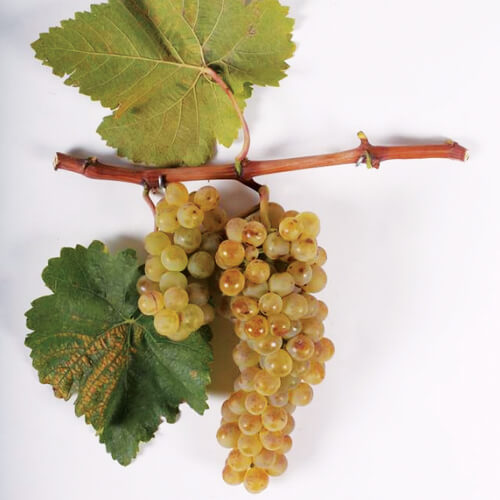
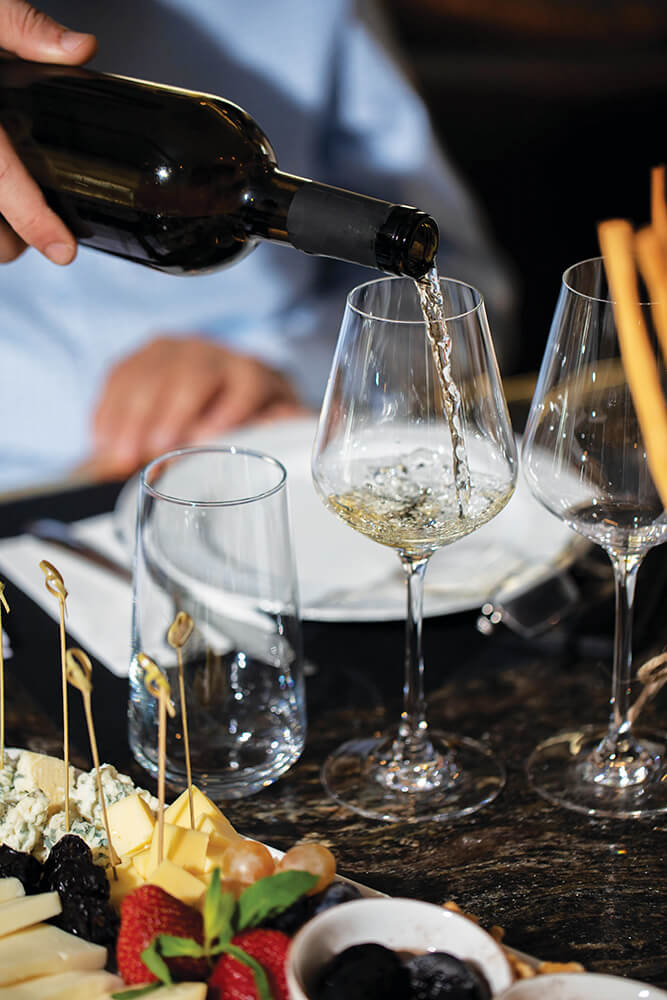
Levan Ujmajuridze: As mentioned by David, we are unable to achieve the desired results in practice when using a pergola system for Chinuri’s cultivation. There are several reasons for this, including soil conditions, choice of rootstock, trunk height, and more. It is essential to ensure that the rootstock is suitable for the specific soil conditions of the designated vineyard. Chinuri is a rapidly growing variety, therefore, when cultivating seedlings, it is crucial to select a rootstock that is suitable for the soil type and is moderate or low vigor. This careful selection will contribute to the optimal development of both vegetative and reproductive organs while maintaining the quantitative and qualitative characteristics of the grapes. Generally, the higher the trunk, the lower the qualitative characteristics of the grape tend to be, this applies even in the case of low-trained formations. Among the grape clusters developed on the shoot, those positioned lower tend to exhibit relatively better quality compared to those positioned at the top. Therefore, when the location of the vineyard site and climate conditions are unsuitable for achieving high grape quality, cultivating Chinuri on a pergola is not recommended.
Honnef Patrick | Technical Director/CEO at JSC Château Mukhrani: Thank you for the invitation, it was a very interesting conversation, a lot of interesting things were learned about this beautiful area. I can only talk about Shida Kartli, because the other ones I am not so informed about. Let’s talk about Chinuri, which we also call Chinebuli. We have about 10 hectares in Château Mukhrani, and we are learning more and more about the different types of Sabatone, white Chinuri, yellow and green Chinuri. This year for example, we have isolated the different varieties as they differ in Mukhrani and Vaziani due to the difference in terroir and microclimate.
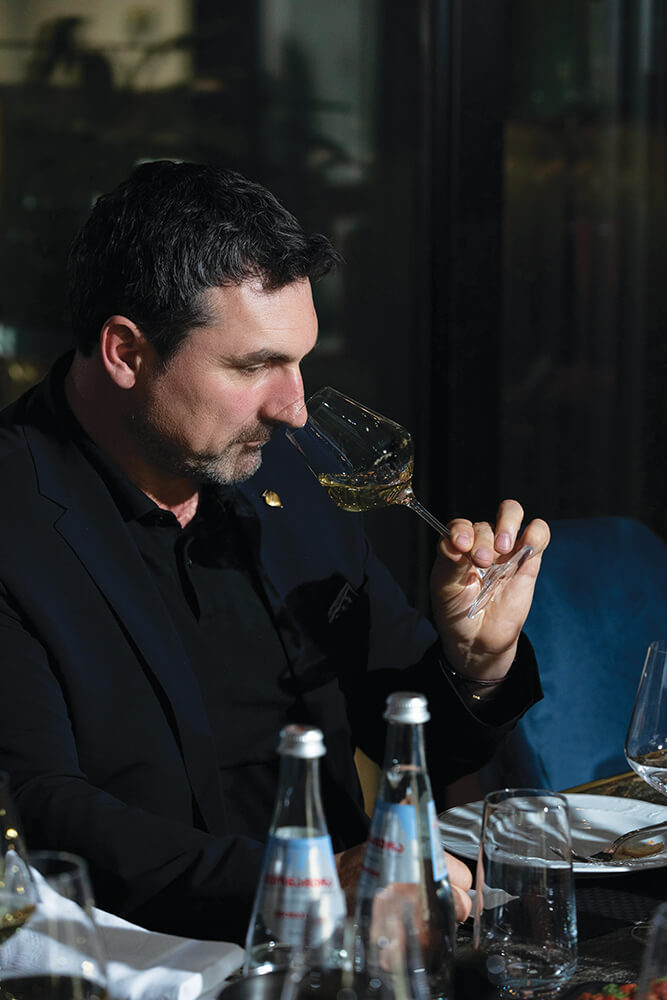
What I think is very interesting about Chinuri, is that it has potential for making either still or sparkling wine, due to the fact that it does not generate high sugar level, which means high alcohol level. Normally, if we hit 11.8% vol it is already considered very high in Mukhrani, 12% is the maximum. At the same time, because of the very nice balance of acidity level, one can create very elegant & fine white wine. People who love powerful wine will not be fans of Chinuri, because it goes more towards the lighter style. But people who like elegant, filigrane, aromatic styles, they will love Chinuri as it is a wine, which due to its character and its diversity, one can drink almost every day. I love the character and the potential of the Chinuri for blends. It’s an excellent blending partner because it can level down the potential of alcohol in the partner wine and reveal more aromatic potential of the blend while giving some minerality. Because what we often see more than acidity, is that they have minerality.
Also, what was very interesting to see, last year, was the difference between white, yellow, and green Chinuries. First of all, the harvest was very different for us, since green Chinuri is harvested later, and its phenolic maturity is reached later than that of white and yellow, depending on the place where it is standing. Personally, I very much enjoyed the style of white Sabatone. We added the blend of white and yellow, which was extremely elegant, and mineral, compared to the green that revealed a more structured and powerful character. Also, all of our wines are naturally fermented, we do not use any technical yeast, we think this can somehow help reveal the varietal character more.
Levan Mekhuzla: Do you have all these varieties planted separately?
Honnef Patrick: Unfortunately, we do not. When we planted it, I didn’t know as much about this. It was hard work to select during the harvest. So, what we do now is that we isolate the areas. In Vaziani there are some areas which are limestone rich, and some more siliceous, and gravelly. We have zones differentiated in order to differentiate the style of vine. Today, with more experience, I would isolate and plant Sabatone and yellow Chinuri more than green because it goes more with our style idea.
Levan Mekhuzla: Do you have the wines to compare the tastes?
Honnef Patrick: Yesterday, I blended it with other Chinuries, so I will ask to have 10-15 more bottles made today, it will be interesting to taste again. We are taking from the rough release, and we have to fill up the tanks. I tasted the result yesterday and I think it is fantastic. Chinuri’s potential for making sparkling wine is great as well. Trying to make certain blend ideas work will be an interesting tradition in Kartli.
Sometimes, I have a flowering problem with Chinuri. Generally, in regard to rootstock, I would not take high vigour rootstock, because it’s very powerful. In Mukhrani area we have a problem with high limestone and low iron, there is also a high EPC, high chloroze index and with 5BBs this will often cause problems. At the moment we are trying to work with 420A and 41B and I am very happy with the result. 420A is more elegant, while 41B is more vigorous, but I’ve never had a problem with chloroze, and this is a very positive result in the research. Next, we are planning to plant more drought -tolerant rootstocks. We as well have 140R from South Africa. For us, what’s most important is to see the chloroze resistance and quality orientation. Overall, we have very good results.
It would also be very interesting to talk about developing new generations. Today we’ve talked about Tavkveri, Shavkapito, and Chinuri, but I think we should talk about other grapes too. I am hoping next year we’ll have great results, so we can have other Kartli varieties in focus.
Giorgi Samanishvili: Patrick mentioned their vineyards, which are cultivated in the Mukhrani Valley and on the slopes. The vineyard in Mukhrani Valley is situated at a relatively high altitude above sea level, but there is a significant difference in elevation between the valley and the foothill slopes. Specifically, the slopes are the ideal locations for cultivating new vineyards.
David Chichua: When discussing the benefits of slopes, we must address the issue of spring frosts. This is a significant concern, particularly in Kartli compared to Imereti, both are two main regions in Georgia with promising prospects for white wine. It is one of Kartli‘s disadvantages and presents a serious problem at least once every 10 years. This is where the advantage of slopes becomes evident, as they are far better protected than lowlands.
Levan Ujmajuridze: We should carefully consider the factors mentioned during the initial evaluation of the vineyard location and plot selection. Adequate exposure is crucial in these regions. It is important to avoid planting vineyards in low-lying areas, particularly near river valleys, as this helps minimize the adverse effects of both winter frosts and spring frost events.
It is also important to consider the influence of rootstocks and the height of the trunk, as they can affect the timing of vegetation for different grape varieties, enabling earlier or relatively late growth. Additionally, there are other preventive measures against early spring frosts that should be considered.
Honnef Patrick: I’d like to say a word about the Vinification of Chinuri which is also a very interesting topic, the discussion we had about Kartli and West Georgia and what is good to be in Qvevri with skin contact or not in Qvevri, I think is a very long, interesting topic for discussion and everybody has their own opinion. I think, in regard to Chinuri, for me it is too filigrane to have too much skin contact, it still makes for a very interesting wine, but we lose much of the varietal character of Chinuri with longer maceration, but it is the question of style in the end. We’re doing tests in Mukhrani as well, when vinifying is done in big oak cask, in a concrete egg & Qvevri, without skin contact. It is interesting to work with the character of Chinuri, both to taste the different varieties, but also to taste Chinuri from different containers. It is quite a discussion to have.
The Chinuri that we have on the market is a blend of 3 different winemaking methods. What I observed as well is that Chinuri, similarly to Shavkapito, is not very expressive after fermentation. Chinuri really needs an aging- or élevage process on the fine lees to express more of its potential. I think working together with the vessel used for vinifying, is what will allow for the style of Chinuri to develop. To ferment Chinuri is quite easy because it’s potential for sugar is low, but it’s potential for style creation is something else.
